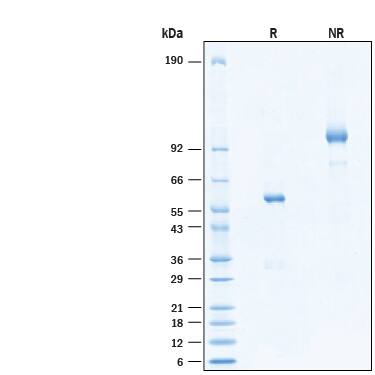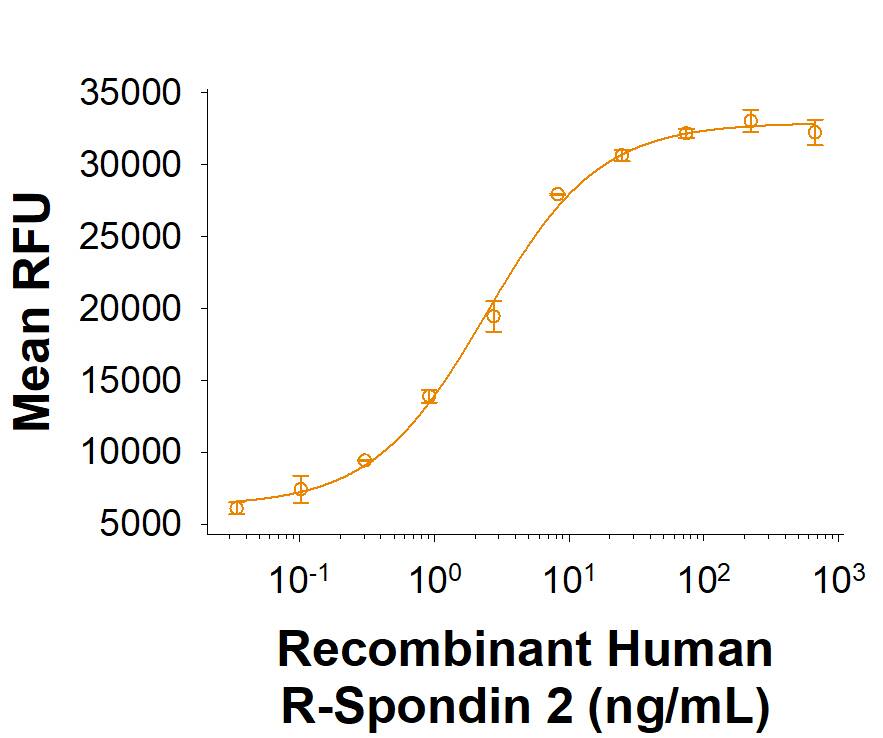Recombinant Human R-Spondin 2 Fc Chimera Protein, CF
R&D Systems, part of Bio-Techne | Catalog # 11427-RS

Key Product Details
Source
CHO
Accession #
Structure / Form
Disulfide-linked homodimer
Conjugate
Unconjugated
Applications
Bioactivity
Product Specifications
Source
Chinese Hamster Ovary cell line, CHO-derived human R-Spondin 2 protein
| Human R-Spondin 2 (Ala32-Gly205) Accession # Q6UXX9.2 |
IEGRMD | Human IgG1 (Pro100-Lys330) |
| N-terminus | C-terminus |
Purity
>95%, by SDS-PAGE visualized with Silver Staining and quantitative densitometry by Coomassie® Blue Staining.
Endotoxin Level
<0.10 EU per 1 μg of the protein by the LAL method.
N-terminal Sequence Analysis
Ala32
Predicted Molecular Mass
47 kDa
SDS-PAGE
53-60 kDa, under reducing conditions.
Activity
Measured
by its ability to activate TCF reporter activity in HEK293 human embryonic
kidney cells in the presence of Recombinant Human Wnt-3a (Catalog #
5036-WN). The ED50 for this effect is 0.400-4.80 ng/mL.
Scientific Data Images for Recombinant Human R-Spondin 2 Fc Chimera Protein, CF
Recombinant Human R‑Spondin 2 Fc Chimera Protein Bioactivity.
Recombinant Human R-Spondin 2 Fc Chimera Protein (Catalog # 11427-RS) activates TCF reporter activity in HEK293 human embryonic kidney cells in the presence of Recombinant Human Wnt-3a (5036-WN). The ED50 for this effect is 0.400-4.80 ng/mL.Recombinant Human R‑Spondin 2 Fc Chimera Protein SDS-PAGE.
2 μg/lane of Recombinant Human R‑Spondin 2 Fc Chimera Protein (Catalog # 11427-RS) was resolved with SDS-PAGE under reducing (R) and non-reducing (NR) conditions and visualized by Coomassie® Blue staining, showing bands at 53-60 kDa and 110-120 kDa, respectively..Formulation, Preparation and Storage
11427-RS
| Formulation | Lyophilized from a 0.2 μm filtered solution in PBS with Trehalose. |
| Reconstitution | Reconstitute at 500 μg/mL in PBS. |
| Shipping | The product is shipped at ambient temperature. Upon receipt, store it immediately at the temperature recommended below. |
| Stability & Storage | Use a manual defrost freezer and avoid repeated freeze-thaw cycles.
|
Background: R-Spondin 2
References
- Kazanskaya, O. et al. (2004) Dev. Cell 7:525.
- Kim, K.-A. et al. (2006) Cell Cycle 5:23.
- Nam, J.-S. et al. (2006) J. Biol. Chem. 281:13247.
- Li, S-J. et al. (2009) Cell Signal. 21:916.
- Swiss-Prot Accession # Q6UXX9.
- Nam, J.-S. et al. (2007) Gene Expr. Patterns 7:306.
- Yamada, W. et al. (2009) Biochem. Biophys. Res. Commun. 381:453.
- Jin, Y.-R. et al. (2011) Dev. Biol. 352:1.
- Nam, J.-S. et al. (2007) Dev. Biol. 311:124.
- Kim, K.-A. et al. (2007) Mol. Biol. Cell 19:2588.
Long Name
Roof Plate-specific Spondin 2
Alternate Names
Cristin 2, RSPO2, RSpondin 2
Gene Symbol
RSPO2
UniProt
Additional R-Spondin 2 Products
Product Documents for Recombinant Human R-Spondin 2 Fc Chimera Protein, CF
Product Specific Notices for Recombinant Human R-Spondin 2 Fc Chimera Protein, CF
For research use only
